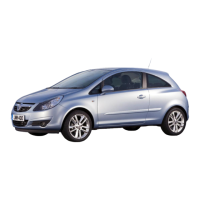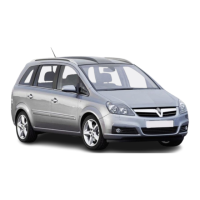Do you have a question about the Vauxhall VX220 and is the answer not in the manual?
Placeholder for entering the vehicle's fuel designation.
Placeholder for entering the vehicle's engine oil grade and viscosity.
Placeholder for entering tyre size and inflation pressure settings.
Placeholder for entering vehicle weights like gross and kerb weight.
Details on key numbers and code numbers for immobilizer and radio systems.
How to unlock the vehicle using the key or remote control.
Instructions on how to adjust the driver's seat for comfort and safety.
How to adjust the lumbar support on the seat for better posture.
Proper method for using the seat belt correctly for safety.
How to adjust interior and exterior mirrors for optimal visibility.
Switches for lights, fog lamps, turn signals, and hazard warning.
Controls for heating, ventilation, and air distribution.
Instruments, odometer reset, and radio system controls.
Horn, ignition switch, bonnet release, and central locking.
Lever for windscreen wipers and wash system operation.
Meaning of fuel, turn signal, and seat belt warning lights.
Meaning of brake, oil pressure, and airbag system warning lights.
Meaning of engine, ABS, alternator, and coolant level warning lights.
What the main beam indicator signifies when active.
How to operate hazard, fog, headlamps, and side lamps.
Switching between dipped, main beam, and headlamp flash.
How to activate left/right turn signals via the steering column lever.
How to use the horn by pressing the button on the steering wheel.
Controls for windscreen wipers and washer fluid operation.
Operation of the ignition switch and steering column lock release.
How to use the starter button to start the engine.
How to shift gears in the manual gearbox, including reverse.
Essential checks before starting a journey for safety.
Caution about the poisonous nature of exhaust gases.
Step-by-step instructions for starting the engine.
How to release the mechanical hand brake.
Advice for careful, economical, and eco-friendly driving.
Steps for parking and securing the vehicle, including on slopes.
Alerts for indicators and headlamps when parking.
Importance of professional vehicle servicing for optimal performance.
Importance of using approved parts for reliability and safety.
Advice on regular checks and entrusting work to approved repairers.
How to use the tachometer for fuel saving and the speedometer.
Fuel level, odometer, and coolant temperature display functions.
Explanation of fuel, turn signal, seat belt, brake, and oil pressure indicators.
Meaning of airbag, engine, ABS, and alternator warning lights.
Meaning of coolant level and main beam indicators.
How the tachometer aids fuel saving and indicates engine speed.
How the speedometer indicates vehicle speed.
Details on fuel level, odometer, and coolant temperature display.
Function of odometer and how to reset trip meter.
How the coolant temperature gauge works and its readings.
General information on vehicle radio reception quality.
Location of the CD multichanger in the load compartment.
Advice on installing and using mobile phones and CB radio.
Precautions for using mobile phones in the vehicle to avoid malfunctions.
Importance of ordering replacement keys from Vauxhall for proper function.
How to lock/unlock doors mechanically or via remote control.
How the immobilizer protects the vehicle against theft.
Using the remote for central locking and alarm activation.
How to operate central locking from inside or with remote.
How to operate the anti-theft alarm system.
How to change batteries in the remote control unit when needed.
Operating central locking from inside and emergency access.
How to activate the alarm and its passenger compartment monitoring.
How to disarm the alarm system.
Information on the alarm's backup siren unit.
How to open the bonnet using the release lever.
How to open the engine and load compartment covers.
Overview of seat belts, tensioners, and airbags.
Proper seat belt use, including for pregnant women.
Step-by-step guide for using seat belts correctly.
Inspecting belts and handling actuated tensioners.
Understanding the indicator for belt tensioners and airbags.
Warnings about accessories and modifications to restraint systems.
Components and conditions for airbag system activation.
How airbags deploy and reduce injury risk.
Situations where the airbag system will not trigger.
How seat and steering wheel position affect airbag effectiveness.
How to interpret the airbag system indicator light.
Warnings regarding accessories, steering wheel, and cleaning.
Information on child seats and carrying heavy objects.
How exterior mirrors react in an accident-like impact.
List of recommended safety accessories like tow ropes and first-aid kits.
How to operate hazard, fog, headlamps, and side lamps.
How the interior lamp and reverse lamp function.
How to adjust the brightness of instrument illumination.
Adjusting headlamps for driving on the opposite side of the road.
How to operate the door windows with the crank.
Advice on installing and removing the hard top.
Detailed steps to remove hard top components.
Detailed steps for installing the hard top securely.
How to remove the soft top canopy and bows.
How to install the soft top canopy and bows.
How the air mixture system regulates temperature.
How to direct airflow using the distribution switch.
How to adjust the cabin temperature using the switch.
How to adjust fan speed and direct airflow from vents.
Settings for maximum ventilation and airflow to different areas.
How to achieve rapid warming of the cabin and foot area.
How to clear windows of mist and frost.
Recommendations for the first 600 miles (1000 km) of driving.
Risks associated with coasting with the engine not running.
How the brake servo unit works when the engine is running.
Specific advice for driving in hilly or mountainous areas.
General approach to driving for fuel efficiency.
Efficient engine warm-up and benefits of uniform speed.
Tips to save fuel by minimizing idling and using higher gears.
Tips for fuel-efficient driving in city conditions and at high speeds.
How tyre pressure, electrical use, and cargo weight affect fuel economy.
Importance of maintenance and factors affecting fuel economy in challenging conditions.
Vauxhall's use of eco-friendly materials and production methods.
How saving fuel contributes to environmental protection.
How driving style impacts noise and emissions.
Maintaining uniform speed reduces noise and emissions.
Tips for minimizing noise in urban driving and effects of high speed.
Advice on closing doors quietly and initial vehicle maintenance.
How optional equipment and new vehicle friction affect fuel use.
Guidance on using high-quality, unleaded petrol with appropriate octane.
Steps for safe and correct refuelling, including using the pump correctly.
How the device isolates fuel supply in a collision.
How to avoid damaging the catalytic converter and ensure emissions compliance.
Importance of regular checks for emissions legislation compliance.
Importance of brake effectiveness, pad wear, and regular maintenance.
How the dual-circuit braking system works.
How the mechanical hand brake secures the vehicle.
What the brake system indicator lights mean.
How ABS prevents wheel lock-up and maintains steering.
How the ABS indicator works and what to do if it indicates a fault.
Importance of using correct tyre size, design, and pattern.
How to check tyre pressures and their importance.
How to check tyres and wheels for damage.
Notes on tyre wear, fitting used tyres, and tyre designations.
Specifics on using winter tyres and special wheels.
Guidelines for using tyre chains on drive wheels.
Warning against using quick chargers on electronic components.
Dangers of starting engine by pushing or towing (catalytic converter).
Detailed instructions and safety precautions for jump starting.
How to tow the vehicle using the towing eye.
Advice on using towing services and obtaining estimates.
Storage of first-aid kit and warning triangle.
Using the emergency tyre inflator aerosol for temporary repair.
How to replace fuses and understanding fuse ratings.
List of fuses and the circuits they protect.
How to replace bulbs in various lights.
Recommendation for professional headlamp alignment.
How to replace bulbs in rear, number plate, and interior lamps.
Recommendation for professional instrument illumination bulb replacement.
Steps for addressing issues with the service department and customer care.
Contact information for Vauxhall service centers worldwide.
Why timely servicing is crucial for vehicle operation and value.
Safety warnings when performing checks or maintenance.
General guide for checking and adding essential vehicle fluids.
How to check and maintain the engine oil level.
When to change engine oil and filters, use of genuine parts.
Details on coolant, pressure, and anti-freeze properties.
Importance of checking coolant concentration for protection.
How to check and replenish coolant levels.
How to interpret coolant temperature readings and warnings.
Importance of correct brake fluid level and type.
Why and when brake fluid should be changed.
How to maintain and operate windscreen wipers.
How to replace wiper blades.
How to refill the washer system and prevent freezing.
Information on the maintenance-free battery and ignition system safety.
Warnings about disconnecting the battery and starting the engine.
Steps for preparing a vehicle for long-term storage.
How to properly store the vehicle to prevent damage.
Work required before putting a vehicle back on the road after storage.
Importance of using Vauxhall-approved care products.
List of recommended products for washing and cleaning.
Recommended methods for washing the vehicle by hand.
How to care for the soft top and advice on exterior storage.
How to wax and polish the vehicle's paint.
Methods for cleaning alloy wheels, exterior lights, and plastic parts.
How to clean interior upholstery and trim.
How to clean seat belts and windows.
How to clean and replace wiper blades.
How to lubricate locks and care for the engine compartment.
Importance of cleaning the underbody after winter.
Location and explanation of vehicle identification number (VIN).
Location of the engine identifier code and number.
Advice on topping up essential vehicle fluids.
Guidance on choosing suitable engine oils and ACEA classifications.
Recommended oil viscosity classes based on temperature.
Technical specifications for different engine types.
EC-standardized fuel consumption and CO2 emission figures.
Permissible gross vehicle weight and kerb weight.
Guidelines on tyre selection and approval.
Requirements for winter tyres and tyre chains.
Recommended tyre pressures for summer and winter tyres.
Details on battery types, voltage, and capacity.
Approximate fluid capacities for cooling system, fuel, and engine oil.
Measurements for length, width, height, and wheelbase.
Advice on mounting number plates to avoid obstructing air intake or heat damage.
Placeholder for entering the vehicle's fuel designation.
Placeholder for entering the vehicle's engine oil grade and viscosity.
Placeholder for entering tyre size and inflation pressure settings.
Placeholder for entering vehicle weights like gross and kerb weight.
Details on key numbers and code numbers for immobilizer and radio systems.
How to unlock the vehicle using the key or remote control.
Instructions on how to adjust the driver's seat for comfort and safety.
How to adjust the lumbar support on the seat for better posture.
Proper method for using the seat belt correctly for safety.
How to adjust interior and exterior mirrors for optimal visibility.
Switches for lights, fog lamps, turn signals, and hazard warning.
Controls for heating, ventilation, and air distribution.
Instruments, odometer reset, and radio system controls.
Horn, ignition switch, bonnet release, and central locking.
Lever for windscreen wipers and wash system operation.
Meaning of fuel, turn signal, and seat belt warning lights.
Meaning of brake, oil pressure, and airbag system warning lights.
Meaning of engine, ABS, alternator, and coolant level warning lights.
What the main beam indicator signifies when active.
How to operate hazard, fog, headlamps, and side lamps.
Switching between dipped, main beam, and headlamp flash.
How to activate left/right turn signals via the steering column lever.
How to use the horn by pressing the button on the steering wheel.
Controls for windscreen wipers and washer fluid operation.
Operation of the ignition switch and steering column lock release.
How to use the starter button to start the engine.
How to shift gears in the manual gearbox, including reverse.
Essential checks before starting a journey for safety.
Caution about the poisonous nature of exhaust gases.
Step-by-step instructions for starting the engine.
How to release the mechanical hand brake.
Advice for careful, economical, and eco-friendly driving.
Steps for parking and securing the vehicle, including on slopes.
Alerts for indicators and headlamps when parking.
Importance of professional vehicle servicing for optimal performance.
Importance of using approved parts for reliability and safety.
Advice on regular checks and entrusting work to approved repairers.
How to use the tachometer for fuel saving and the speedometer.
Fuel level, odometer, and coolant temperature display functions.
Explanation of fuel, turn signal, seat belt, brake, and oil pressure indicators.
Meaning of airbag, engine, ABS, and alternator warning lights.
Meaning of coolant level and main beam indicators.
How the tachometer aids fuel saving and indicates engine speed.
How the speedometer indicates vehicle speed.
Details on fuel level, odometer, and coolant temperature display.
Function of odometer and how to reset trip meter.
How the coolant temperature gauge works and its readings.
General information on vehicle radio reception quality.
Location of the CD multichanger in the load compartment.
Advice on installing and using mobile phones and CB radio.
Precautions for using mobile phones in the vehicle to avoid malfunctions.
Importance of ordering replacement keys from Vauxhall for proper function.
How to lock/unlock doors mechanically or via remote control.
How the immobilizer protects the vehicle against theft.
Using the remote for central locking and alarm activation.
How to operate central locking from inside or with remote.
How to operate the anti-theft alarm system.
How to change batteries in the remote control unit when needed.
Operating central locking from inside and emergency access.
How to activate the alarm and its passenger compartment monitoring.
How to disarm the alarm system.
Information on the alarm's backup siren unit.
How to open the bonnet using the release lever.
How to open the engine and load compartment covers.
Overview of seat belts, tensioners, and airbags.
Proper seat belt use, including for pregnant women.
Step-by-step guide for using seat belts correctly.
Inspecting belts and handling actuated tensioners.
Understanding the indicator for belt tensioners and airbags.
Warnings about accessories and modifications to restraint systems.
Components and conditions for airbag system activation.
How airbags deploy and reduce injury risk.
Situations where the airbag system will not trigger.
How seat and steering wheel position affect airbag effectiveness.
How to interpret the airbag system indicator light.
Warnings regarding accessories, steering wheel, and cleaning.
Information on child seats and carrying heavy objects.
How exterior mirrors react in an accident-like impact.
List of recommended safety accessories like tow ropes and first-aid kits.
How to operate hazard, fog, headlamps, and side lamps.
How the interior lamp and reverse lamp function.
How to adjust the brightness of instrument illumination.
Adjusting headlamps for driving on the opposite side of the road.
How to operate the door windows with the crank.
Advice on installing and removing the hard top.
Detailed steps to remove hard top components.
Detailed steps for installing the hard top securely.
How to remove the soft top canopy and bows.
How to install the soft top canopy and bows.
How the air mixture system regulates temperature.
How to direct airflow using the distribution switch.
How to adjust the cabin temperature using the switch.
How to adjust fan speed and direct airflow from vents.
Settings for maximum ventilation and airflow to different areas.
How to achieve rapid warming of the cabin and foot area.
How to clear windows of mist and frost.
Recommendations for the first 600 miles (1000 km) of driving.
Risks associated with coasting with the engine not running.
How the brake servo unit works when the engine is running.
Specific advice for driving in hilly or mountainous areas.
General approach to driving for fuel efficiency.
Efficient engine warm-up and benefits of uniform speed.
Tips to save fuel by minimizing idling and using higher gears.
Tips for fuel-efficient driving in city conditions and at high speeds.
How tyre pressure, electrical use, and cargo weight affect fuel economy.
Importance of maintenance and factors affecting fuel economy in challenging conditions.
Vauxhall's use of eco-friendly materials and production methods.
How saving fuel contributes to environmental protection.
How driving style impacts noise and emissions.
Maintaining uniform speed reduces noise and emissions.
Tips for minimizing noise in urban driving and effects of high speed.
Advice on closing doors quietly and initial vehicle maintenance.
How optional equipment and new vehicle friction affect fuel use.
Guidance on using high-quality, unleaded petrol with appropriate octane.
Steps for safe and correct refuelling, including using the pump correctly.
How the device isolates fuel supply in a collision.
How to avoid damaging the catalytic converter and ensure emissions compliance.
Importance of regular checks for emissions legislation compliance.
Importance of brake effectiveness, pad wear, and regular maintenance.
How the dual-circuit braking system works.
How the mechanical hand brake secures the vehicle.
What the brake system indicator lights mean.
How ABS prevents wheel lock-up and maintains steering.
How the ABS indicator works and what to do if it indicates a fault.
Importance of using correct tyre size, design, and pattern.
How to check tyre pressures and their importance.
How to check tyres and wheels for damage.
Notes on tyre wear, fitting used tyres, and tyre designations.
Specifics on using winter tyres and special wheels.
Guidelines for using tyre chains on drive wheels.
Warning against using quick chargers on electronic components.
Dangers of starting engine by pushing or towing (catalytic converter).
Detailed instructions and safety precautions for jump starting.
How to tow the vehicle using the towing eye.
Advice on using towing services and obtaining estimates.
Storage of first-aid kit and warning triangle.
Using the emergency tyre inflator aerosol for temporary repair.
How to replace fuses and understanding fuse ratings.
List of fuses and the circuits they protect.
How to replace bulbs in various lights.
Recommendation for professional headlamp alignment.
How to replace bulbs in rear, number plate, and interior lamps.
Recommendation for professional instrument illumination bulb replacement.
Steps for addressing issues with the service department and customer care.
Contact information for Vauxhall service centers worldwide.
Why timely servicing is crucial for vehicle operation and value.
Safety warnings when performing checks or maintenance.
General guide for checking and adding essential vehicle fluids.
How to check and maintain the engine oil level.
When to change engine oil and filters, use of genuine parts.
Details on coolant, pressure, and anti-freeze properties.
Importance of checking coolant concentration for protection.
How to check and replenish coolant levels.
How to interpret coolant temperature readings and warnings.
Importance of correct brake fluid level and type.
Why and when brake fluid should be changed.
How to maintain and operate windscreen wipers.
How to replace wiper blades.
How to refill the washer system and prevent freezing.
Information on the maintenance-free battery and ignition system safety.
Warnings about disconnecting the battery and starting the engine.
Steps for preparing a vehicle for long-term storage.
How to properly store the vehicle to prevent damage.
Work required before putting a vehicle back on the road after storage.
Importance of using Vauxhall-approved care products.
List of recommended products for washing and cleaning.
Recommended methods for washing the vehicle by hand.
How to care for the soft top and advice on exterior storage.
How to wax and polish the vehicle's paint.
Methods for cleaning alloy wheels, exterior lights, and plastic parts.
How to clean interior upholstery and trim.
How to clean seat belts and windows.
How to clean and replace wiper blades.
How to lubricate locks and care for the engine compartment.
Importance of cleaning the underbody after winter.
Location and explanation of vehicle identification number (VIN).
Location of the engine identifier code and number.
Advice on topping up essential vehicle fluids.
Guidance on choosing suitable engine oils and ACEA classifications.
Recommended oil viscosity classes based on temperature.
Technical specifications for different engine types.
EC-standardized fuel consumption and CO2 emission figures.
Permissible gross vehicle weight and kerb weight.
Guidelines on tyre selection and approval.
Requirements for winter tyres and tyre chains.
Recommended tyre pressures for summer and winter tyres.
Details on battery types, voltage, and capacity.
Approximate fluid capacities for cooling system, fuel, and engine oil.
Measurements for length, width, height, and wheelbase.
Advice on mounting number plates to avoid obstructing air intake or heat damage.
| Brand | Vauxhall |
|---|---|
| Model | VX220 |
| Category | Automobile |
| Language | English |











